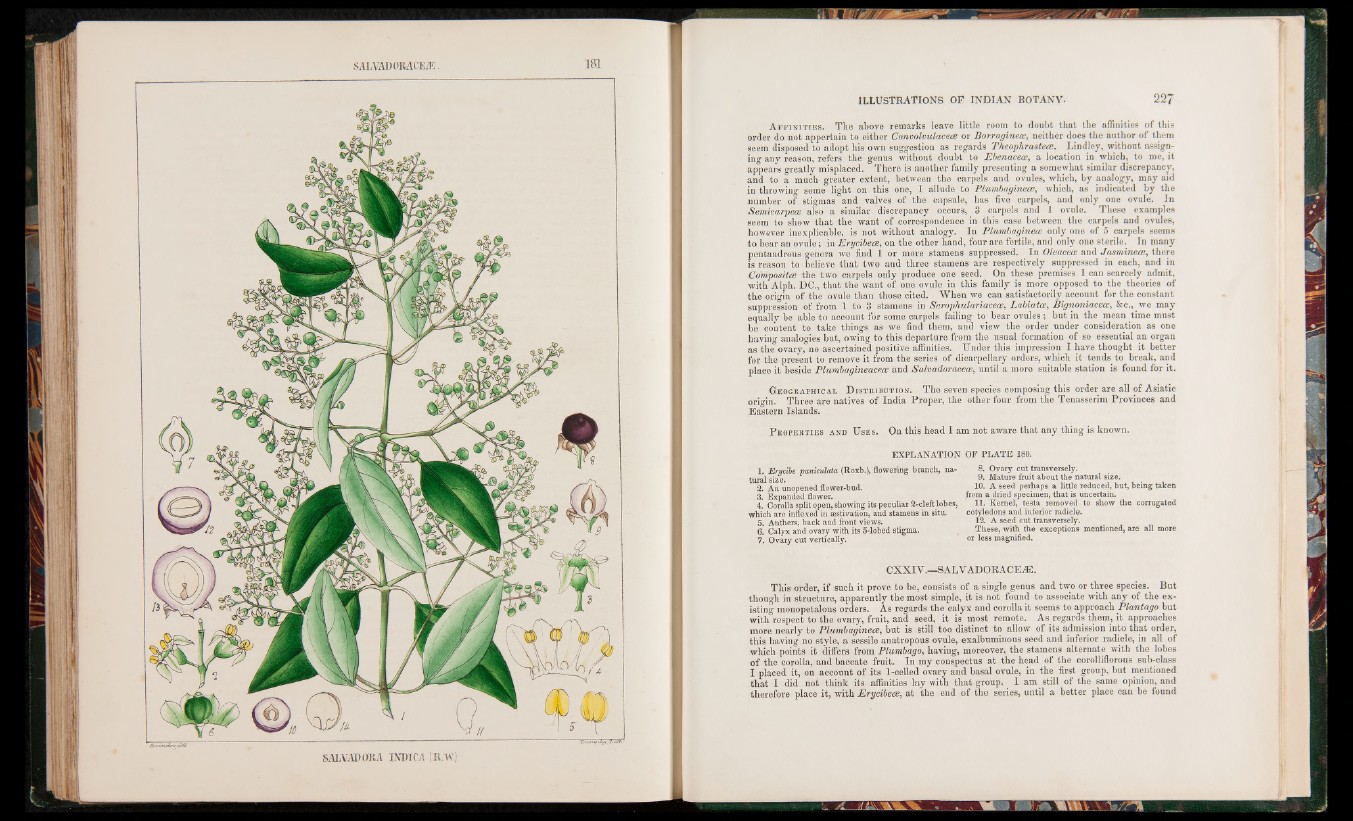
A f f in i t i e s . The above remarks leave little room to doubt that the affinities of this
order do not appertain to either Convolvulacece or Borraginece, neither does the author of them
seem disposed to adopt his own suggestion as regards Theophrastece. Lindley, without assigning
any reason, refers the genus without doubt to Ebenacece, a location in which, to me, it
appears greatly misplaced. There is another family presenting a somewhat similar discrepancy,
and to a much greater extent, between the carpels and ovules, which, by analogy, may aid
in throwing some light on this one, I allude to Plumbaginete, which, as indicated by the
number of stigmas and valves of the capsule, has five carpels, and only one ovule. In
Semicarpeos also a similar discrepancy occurs, 3 carpels and I ovule. These examples
seem to show that the want of correspondence in this case between the carpels and ovules,
however inexplicable, is not without analogy. In Plumbaginete only one of 5 carpels seems
to bear an ovule; in Erycibece, on the other hand, four are fertile, and only one sterile. In many
pentandrous genera we find 1 or more stamens suppressed. In Oleaeece and Jasmineee, there
is reason to believe that two and three stamens are respectively suppressed in each, and in
Composites the two carpels only produce one seed. On these premises I can scarcely admit,
with Alph. DC., that the want of one ovule in this family is more opposed to the theories of
the origin of the ovule than those cited. When we can satisfactorily account for the constant
suppression of from 1 to 3 stamens in Scrophulariacece, Labiates, Bignoniaceoe, &c., we may
equally be able to account for some carpels failing to bear ovules ; but in the mean time must
be content to take things as we find them, and view the order under consideration as one
having analogies but, owing to this departure from the usual formation of so essential an organ
as the ovary, no ascertained positive affinities. Under this impression I have thought it better
for the present to remove it from the series of dicarpellary orders, which it tends to break, and
place it beside Plumbagineaceas and Salvadoracece, until a more suitable station is found for it.
G eo gk a ph ica l D i s t r ibu t io n . The seven species composing this order are all of Asiatic
origin. Three are natives of India Proper, the other four from the Tenasserim Provinces and
Eastern Islands.
P r o p e r t ie s a n b U s e s . On this head I am not aware that any thing is known.
EXPLANATION OF PLATE 180.
1. Erycibe pamculala (Roxb.), flowering branch, na-
tural size.
2. An unopened flower-bud.
3. Expanded flower.
4. Corolla split open, showing its peculiar 2-cleft lobes,
which are inflexed in aestivation, and stamens in situ.
5. Anthers, back and front views.
6. Calyx and ovary with its 5-lobed stigma.
7. Ovary cut vertically.
8. Ovary cut transversely.
9. Mature fruit about the natural size.
10. A seed perhaps a little reduced, but, being taken
from a dried specimen, that is uncertain.
11. Kernel, testa removed to show the corrugated
cotyledons and inferior radicle.
12. A seed cut transversely.
These, with the exceptions mentioned, are all more
or less magnified.
CXXIY.—SALVADORACECE.
This order, if such it prove to be, consists of a single genus and two or three species. But
though in structure, apparently the most simple, it is not found to associate with any of the existing
monopetalous orders. As regards the calyx and corolla it seems to approach Plantago but
with respect to the ovary, fruit, and seed, it is most remote. As regards them, it approaches
more nearly to Plumbaginece, but is still too distinct to allow of its admission into that order,
this having no style, a sessile anatropous ovule, exalbuminous seed and inferior radicle, in all of
which points it differs from Plumbago, having, moreover, the stamens alternate with the lobes
of the corolla, and baccate fruit. In my conspectus at the head of the corolliflorous sub-class
I placed it, on account of its 1-celled ovary and basal ovule, in the first group, but mentioned
that I did not think its affinities lay with that group. I am still of the same opinion, and
therefore place it, with Erycibece, at the end of the series, until a better place can be found